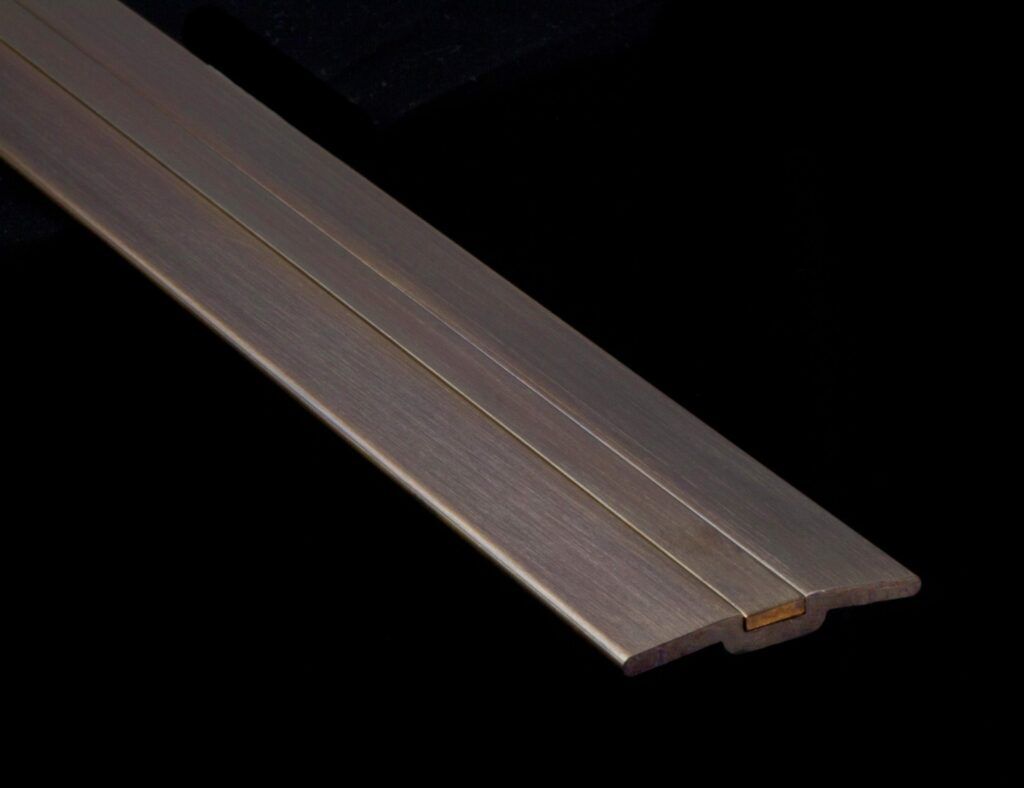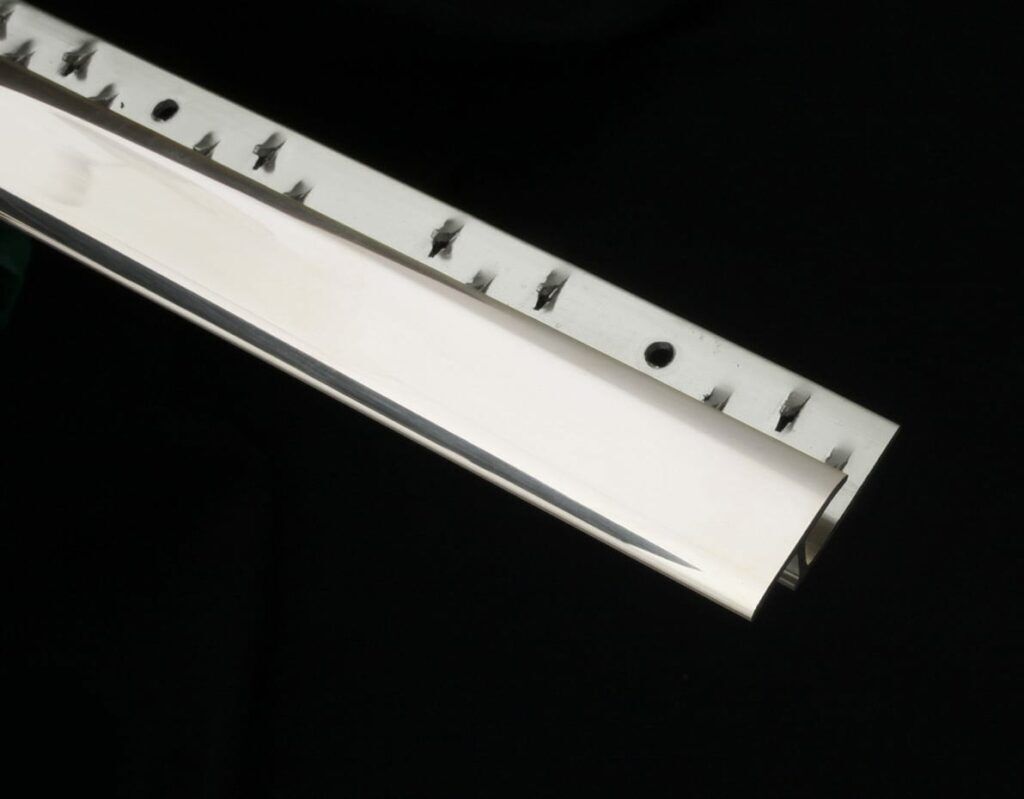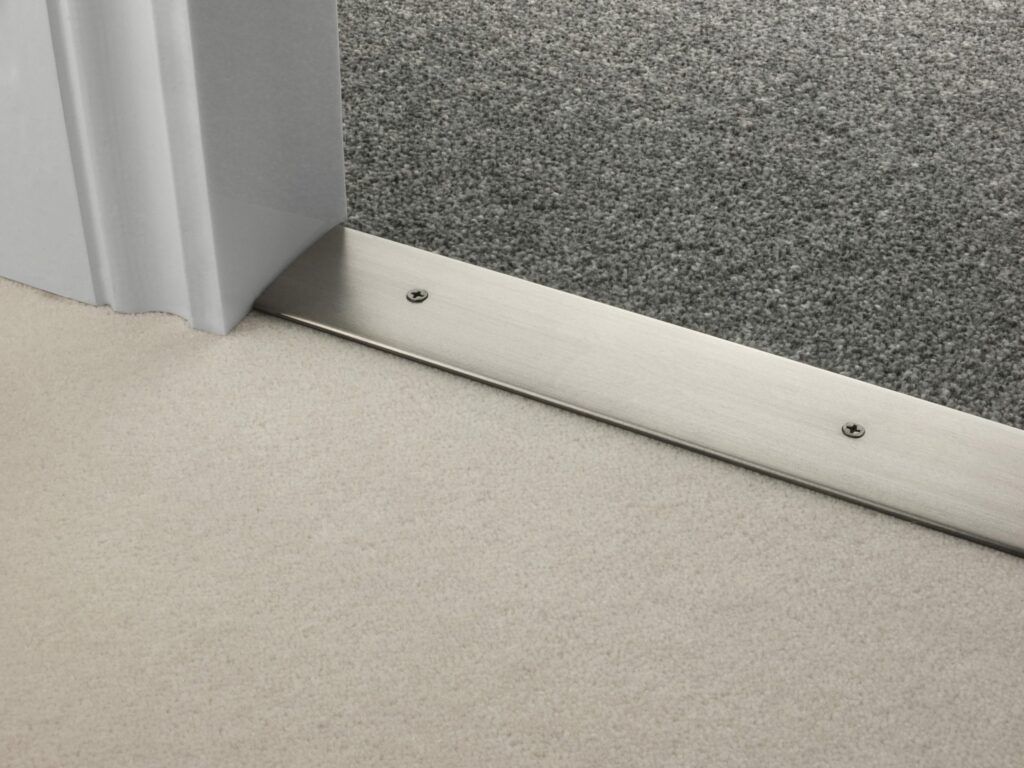A common query from home owners getting to grips with home improvements is how you should fix carpet to tile with a transition. So, in this post I’m going highlight the door threshold options available, how they work, and on the way mention a few pitfalls you’ll probably want to avoid. Don’t worry, I’ll keep it simple…
First thing to note is that you can fit them when your flooring first goes down or retrospectively. Both options work well.
And secondly, I think it is important to get a handle on floor levels, particularly the sub floor level. Floor heights influence the type of transition strips you should purchase.
The living room carpet to hall tile scenario
Let’s imagine you have a carpeted living room – a nice, wool twist already, fitted on top of a decent underlay. You’ve decided to pull up the old Axminster carpet in the hall, which has seen better days, and gone for a stone-look, ceramic tile floor instead. So, no more moaning when the dog tramples in mud and drops sticks in the hallway; in future, you’ll simply mop up.
You also want a smooth transition from your living room carpet to the new tiles in the hall – something which reflects the cost and the effort you are putting in. So, which type of door bar do you choose to join your living room carpet to your ceramic tiles?
Let’s understand the carpet to tile transition options
There are a few different types in the marketplace. Here, I’ll explain how the two most popular work and when you should/should not use each one.
All you need to know about Z bars
The Z-bar is so named after its (sort of) Z-shaped profile. Looking down on it, on one side you have a hooked base plate (the bottom of the letter “Z”), which grips the carpet from underneath and holds it firm. You therefore won’t see this hooked plate when the carpet has been pulled onto it. On the tile side there is just a void under the bar where the tile fits under. Meanwhile, the top of the “Z” is the visible transition bar, typically 25-40mm wide, which neatly fits over the edge of the tile on one side and over the cut edge of the carpet on the other. Once fixed in position, the Z bar is carefully “napped down” which means the central vertical compresses down slightly for a secure fit.
A quality Z bar is in my opinion the best option. They not only cover up the raw edges of the cut tile and stop the cut carpet from fraying but act as the carpet gripper across the doorway. This means they help keep the carpet under tension, avoiding annoying carpet rucks, and they look neat and smart.
There are several variations of the Z bar, including the gold standard brass ones, plus Z bars for extra thick carpets, Z bars which are slim, Z bars made of aluminium and so on. They all work much the same way.
In essence Z bars join a carpet to any type of hard floorcovering, not just ceramic tiles. So, you can use them joining to wood, laminate, stone, in addition to ceramic tiles.
HOWEVER, check your floor heights before buying
The hooked base plate which attaches to the sub floor (by glue or nails) and lies under your carpet MUST lie entirely flat on the sub floor. Note: your underlay stops short of it and only the carpet fits over the hooks. This therefore means that the visible transition bar which you see in the doorway, will likewise lie flat and parallel to the base plate. As you will soon realise, you therefore need to measure the drop from the top of the installed tile to the sub floor and make sure there is enough space for the thickness of your tile when the hooked base strip is lying flat on the sub floor beneath the carpet.
I know with the Premier Zs the manufacturer supplies a few shims (pieces of mdf or similar) with each one so that you can lift up the base plate a little (just a couple of millimetres) should you need to.
If your floors are not level, then you will need to consider the following:
- Lifting the carpeted side up using an Easyshim, in so doing creating a raised sub floor level and then you should be able to use a Z bar.
- Or, using a carpet ramp to bridge the height difference.
And what about the second option of Cover Plates?
Unlike a Z-bar, with a Cover Plate there is no hooked base plate to hold the carpet. They simply straddle the join between the carpet and the other floor (in our scenario this is a tile). What you see from above is a visible bar or cover plate. They therefore cover up the cut edge of the carpet and of the tile. However, they DO NOT hold the carpet in place, under tension, and you’ll need to instead use gripper across your doorway, under your carpet (like you have around the room) to fix the carpet to the floor.
Cover plates are fixed to the subfloor with screws. Sometimes the screws are a feature of the plate and lie flush, other designs they are covered up.
Hopefully, you are still with me but what about the tile thickness and floor height issues, which can occur with Z bars? Are they likewise and issue with cover plates? If you choose the right brand of cover plate, then they are designed to be installed flat or at an angle. For example, both the Premier Posh and Premier Cover come in three different widths (30mm, 38mm and 55mm) and the wider 55mm option can cope with floor level differences of up to 9mm.

What’s more, the cover plates are adaptable – you can use them to join all sorts of flooring and combinations of flooring including carpets, tiles, wood, vinyl etc., so you can match the door thresholds throughout your home, whatever the flooring you are joining.
A few final suggestions
- Do get to grips with your floor levels before you buy your carpet to tile transition to ensure you purchase the correct design.
- Don’t screw into a floor which has/may have underfloor heating elements or pipes, use a transition which can be glued down instead.
- Remember the nice twist carpet and the new, stone-look tiles being fitted in the hall? If you’ve invested in quality flooring, don’t skimp on the quality of the transition strips.
- Z bars and cover plates manufactured in brass are typically higher quality than cheap aluminium strips; the latter have a reputation for denting and bending quite easily.

 0330 113 4909
0330 113 4909 
